| Information | Note |
|---|
| Late or very late apex, where the first (fast) part of the corner is less important compared to the second (slow) part. The first part of the corner has been omitted in the notes. Example: R4late or MRlate
| late |
| "Tightens" or "Closes". Corner is immediately, without any straight, followed by a slower corner in the same direction. The slower grade will be indicated if there is a difference of more than two steps in the grades as L6 >5-, which means the L6 continues into a L5-. In this example "L6 >5-" is a short form for "L6 into L5-"
| > |
| "Opens". As above but indicating a faster grade. Grade is not given for the continuation.
| < |
| "Opens and tightens". A combination where the first section is followed by a faster section and finally a slower section. Grade (but not direction) is usually given also for the last section. Note that the last section may be faster than the first section. This makes it possible to see combinations like: L3<>4 or (KL<>M). It may also be combined with duration(s) like L3<'lg>4 or (KL<'lg>M) or even L3< /150 >4 or (KL< /150 >M).
| <> |
| Information | Note |
|---|
| A second corner/object has to be taken into consideration for line on the road for the first corner/object, eg. L4 into R3, means that there is no time to change your line after the L4, and that the driver may need to take a slightly different line to allow for the R3 | into |
| A brief distance between corners, less than 40 yards, just allowing limited change of line | |
| A slightly longer distance between corners/objects, usually between 40-60 yards | 50 |
| Distance in yards between corners/objects. Shorter distances than 50 yards are given only if it is very important, eg. Cr 30 L4. | 50, 70, 100, 120, 150, 180, 200, 250... |
| A straight with less severe than 6+ slight corners in both R and L direction eg. kinks 150. | kinks |
| Information | Note |
|---|
Small crest/brow. There may be two different reasons for giving a small crest in the notes:
1) You can not see the road at the end of a straight due to a crest that has marginal influence on the handling of the car.
2) There is a crest in a corner (you will usually see the road after it) and it will have some influence on the handling of the car. | smCr |
| Crest/brow. You lose a considerable amount of grip when passing a crest. | Cr |
| Big crest. Road falls away steeply on the backside of Cr - big loss of grip. | BigCr |
| Action on top of crest (Example: turn L3 onCr) | onCr |
| Long (small) crest is where the crest continues over a longer distance, making it difficult to define the peak.
NOTE! Distance measurement to a long crest ends where the first impression of a peak seems to be and starts when you see the road past the crest. | lgCr, lgsmCr |
| Crest over 70 indicates a long crest over a straight of 70 yards | Cr/70 |
| Small jump, car loose a lot of traction because of a crest | smJmp |
| Jump, car may leave the ground | Jmp |
| Big jump, car will leave the ground | BigJmp |
| Short sharp crest that will unsettle the car abruptly | kick |
| Bump, the road surface may be uneven as a result of ruts across the road, rocks poking up or other situations which will disturb the handling of the car when hit | bmp |
| Big bump, severe bump (potentially car damaging) | BigBmp |
| Dip, road in a shallow V shape | dip |
| Information | Note |
|---|
| Denote something that may be true. Mainly water or slippy have got this information as they may change over time. It may be read "maybe". | ? |
| Bridge or cattle grid | ][ |
| Cattle guard | guard |
| Exposure/drop right, left or outside corner. To reduce number of terms to read this implies a caution without being explicitly printed | DropR, DropL, Drop outside |
| Junction which you pass | Jct, past Jct, rd L, rd R |
| No cut. Stone or other obstacle inside corner | n.c. |
| Road narrows | nar |
| Off camber | o.c. |
| Rough | ruf |
| Keep lefthand/middle/righthand side of road over crest or through corner | stay L, stay middle, stay R |
| Through | thru |
| Junction where you turn. Distance from start to junction is given under note. When the turn is a considerable change in direction and no space is left to overshoot: At T (-junction) is given. Example: turn R4@T | turn (@T) |
 Mail Arne
Mail Arne Mail Arne
Mail Arne Home
Home
